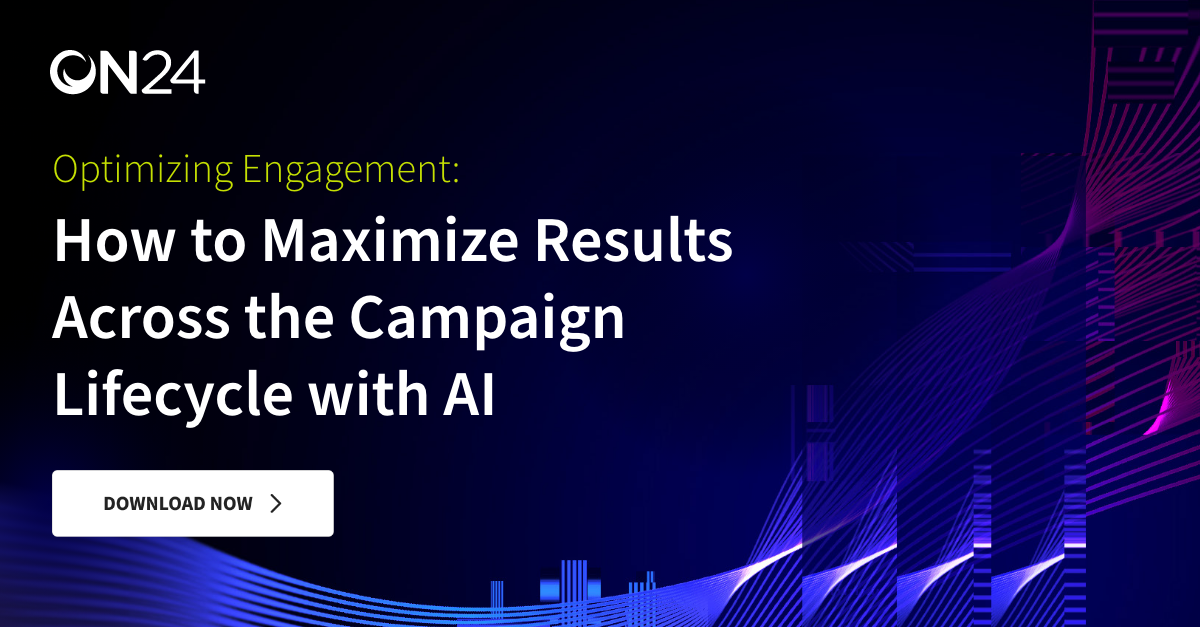How B2B Marketers can Write Great Generative AI Content Prompts

Generative Artificial Intelligence solutions are likely here to stay. And for today’s digital marketers, that means understanding how to effectively use these tools to drive measurable results.
Often, that means coming up with a process for prompt engineering — the process of drafting, testing and optimizing instructions for chat-based AI tools like ChatGPT, Google’s Bard and Anthropic’s Claude. The role of AI prompts is important — especially for generative AI, as it helps AI programs properly interpret your request. Simply put, the better the prompt you provide, the better the output you’ll get.
But what does a good AI prompt look like? Below is a template that you can use to create a prompt you can copy and adapt for your own use, followed by a real example and output.
Opportunities for AI to enhance event content creation
Today’s AI can be used for many types of content. Here are a few possibilities:
Brainstorm – Stuck for ideas on event content? Chat tools powered by large language models (LLMs) such as ChatGPT or Anthropic’s Claude can provide you with a list of topics, titles, formats and more.
Educate on industry jargon – AI can be used to create clear and simple definitions for complex terms and language. Tools connected to the internet, such as Bing Chat, can also search for the most up-to-date information and terminology.
Outline development – High-quality events need a relevant agenda, a clear structure and engaging content. AI can be used to create a suggested outline for any experience or event you have planned. ON24 SmartText can also create session titles and abstracts that you can use to kickstart your event creation.
Poll and survey questions – Asking for the audience’s opinion is a great way to both maximize engagement and learn more about them. By providing an AI tool with the title and outline for a presentation or keynote, it can suggest a list of questions to ask to get your audience involved.
Image creation – Searching for the right stock images or graphics can be a time-consuming and frustrating task. Fortunately, tools such as Midjourney or Adobe Firefly can rapidly create unique images to help you tell your story.
Slide Creation – Generative AI isn’t limited to text and images in isolation. Tools such as Microsoft Copilot for PowerPoint promise to make the task of slide and presentation creation easier than ever.
Animations – While AI animations are still developing, open-source solutions such as Deforum Stable Diffusion are already producing impressive results. Other tools include Synthesia, which generates AI-based actors to explain content.
Video clips – Previously recorded content provides a great way to turn your existing content into snippets for both event promotion and content creation. Within the ON24 platform, Key Moments and Video Builder allow you to maximize the potential of your pre-existing content.
Generative AI prompt template:
The following is a generative AI prompt template that B2B content marketers can adapt for their own use:
I want you to act as an award-winning B2B content marketer, who is an expert on {YOUR COMPANY’S INDUSTRY OR KEY OFFERING}.
I want you to write an {OUTPUT e.g. e-book outline, blog post, marketing email} that will be used for {PURPOSE} for a {WHAT YOUR COMPANY IS e.g. healthcare devices manufacturer}.
Below is the brief.
-
- The title: {TITLE}
- The intended audience: {JOB TITLE / PERSONA DETAILS} working at companies that have the following characteristics: {TARGET ACCOUNT FIRMOGRAPHICS, SIZE, INDUSTRY ETC.}
- The audience has the following needs: {NEEDS, PAINS, GAINS}
- The context / background that makes this content necessary: {CONTEXT/BACKGROUND e.g. part of a campaign, product announcement, standalone piece, etc.}
- Important themes / angles / messages that should be covered are: {KEY THEMES, ANGLES OR MESSAGES}
- Where the asset will be published or used: {NAME OR DESCRIPTION OF WEBSITES/CHANNELS AND LOCATIONS WHERE CONTENT WILL BE}
- The objective is: {OBJECTIVE}
- In terms of the buyer’s journey, this content is {TOP OF FUNNEL / MIDDLE OF FUNNEL / BOTTOM OF FUNNEL}
- After the audience has read this content, I want them to: {DESIRED OUTCOMES AND READER ACTIONS, THOUGHTS, FEELINGS}
- The tone and style of the post should be: {TONE OF VOICE AND STYLE}.
- A publication that uses a similar tone of voice and style is {EXAMPLE PUBLICATION}
- The keywords I want to use include: {KEYWORDS AND FREQUENCY}
- The following words / phrases should NOT be included: {BANNED WORDS}
Now, please proceed with the content written in {MARKDOWN / HTML / PLAIN TEXT}. Structure the content as needed with heading tags e.g. {H1/#}, with subheadings and bullet points as necessary.
Example Prompt
Here is an example of the above template in use:
I want you to act as an award-winning B2B content marketer, who is an expert on virtual events and digital experiences.
I want you to write a detailed outline of an e-book that will be used for top-of-funnel demand generation for a virtual event technology vendor.
Below is the brief.
-
- The title: “The Complete Guide To Running a Virtual Event.”
- The intended audience: B2B demand generation marketers working at companies that have the following characteristics: Mid-market and enterprise; works to support SDR/BDR team in generating pipeline; Uses CRM and marketing automation technology such as Salesforce, Marketo, HubSpot and Eloqua.
- The audience has the following needs: Need high-quality, engaged buyers; Struggle to provide sales-ready leads in sufficient quantity or quality; Want to deliver a measurable impact to pipeline.
- The context / background: Support the SaaS vendor’s positioning that virtual events help to drive deep engagement with audiences and accelerate buyer journeys.
- Where the asset will be published: To be published on the tech vendor’s website, distributed through content syndication and placements trade media websites.
- The objective is: To get B2B marketers to consider using virtual events as a key part of their demand generation and go-to-market strategy and demand generation strategies.
- In terms of the buyer’s journey, this content is top-of-funnel (TOFU).
- After the audience has read this content, I want them to: download and engage with further assets on our website and consider solutions to improve their use of virtual events.
- The tone and style of the post should be: Friendly, informal, educational, practical, useful, free of buzzwords and cliches – written in US English, AP Style.
- A publication that uses a similar tone of voice and style is: https://contentmarketinginstitute.com/
- The keywords I want to use include: virtual events; engagement; on-demand viewing; sales enablement.
- The following words / phrases should NOT be included: Leverage; synergies; boil the ocean.
Now, please proceed with the outline written in Markdown. The title of the blog post should be marked with a {/#} tag, with subheadings as {##}, and you should include key points as bullets under each subheading.
Example Response
The Complete Guide To Running a Virtual Event
Introduction
-
- Brief overview of the transformation of the events industry.
- Highlight on the rise of virtual events in recent years.
- Explanation of how virtual events can deepen engagement and accelerate buyer journeys.
Why Virtual Events?
-
- The decline of traditional, in-person events due to various factors, including global pandemics and changing business practices.
- The advantages of virtual events:
o Scalability
o Accessibility for global audiences
o Flexibility in content delivery (live vs. on-demand viewing)
o Improved data collection and analytics capabilities
Understanding Engagement in Virtual Events
-
- Defining what true ‘engagement’ means in the context of online events.
- Discussing interactive features and how they enhance attendee experiences.
- Mentioning the importance of on-demand viewing and its relation to enhanced engagement.
How Virtual Events Accelerate the Buyer Journey
-
- The importance of high-quality, engaged buyers for B2B demand generation.
- How virtual events create a direct line of communication between companies and their target audience.
- The role of virtual events in sales enablement: providing sales-ready leads in quantity and quality.
Virtual Event Best Practices for B2B Marketers
-
- Tips and tricks to make a virtual event stand out.
- Importance of content: how to craft content that resonates and educates.
- Technical considerations: ensuring smooth streaming, interaction, and on-demand playback.
- Promoting your event: reaching the right audience and maximizing attendance.
Measuring Success: Analytics and ROI
-
- Overview of metrics that matter for virtual events.
- Discussing how CRM and marketing automation technologies (like Salesforce, Marketo, HubSpot, and Eloqua) integrate with virtual events platforms.
- Techniques for post-event follow-up and nurturing leads.
Overcoming Common Challenges
-
- Addressing common concerns and roadblocks B2B marketers face when considering virtual events.
- Tips for ensuring high engagement and turnout.
- Strategies to ensure the virtual event provides sales-ready leads.
Next Steps: Beyond the Virtual Event
-
- How to leverage virtual event content post-event.
- Encouraging audience to engage with further assets on your website.
- Building long-term relationships with attendees.
Conclusion
-
- A call to action for B2B marketers to consider virtual events as a core strategy.
- Highlighting the role of virtual events in driving deep engagement and supporting sales enablement efforts.
Additional Resources
-
- Links to further reading, whitepapers, webinars, and other assets on the vendor’s website related to virtual events.


